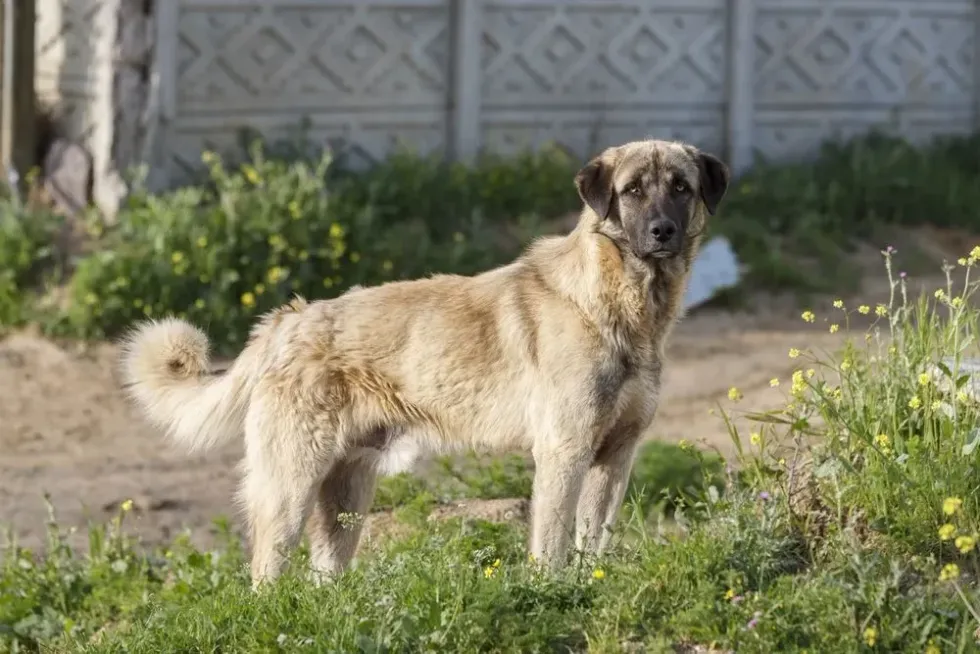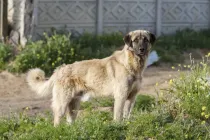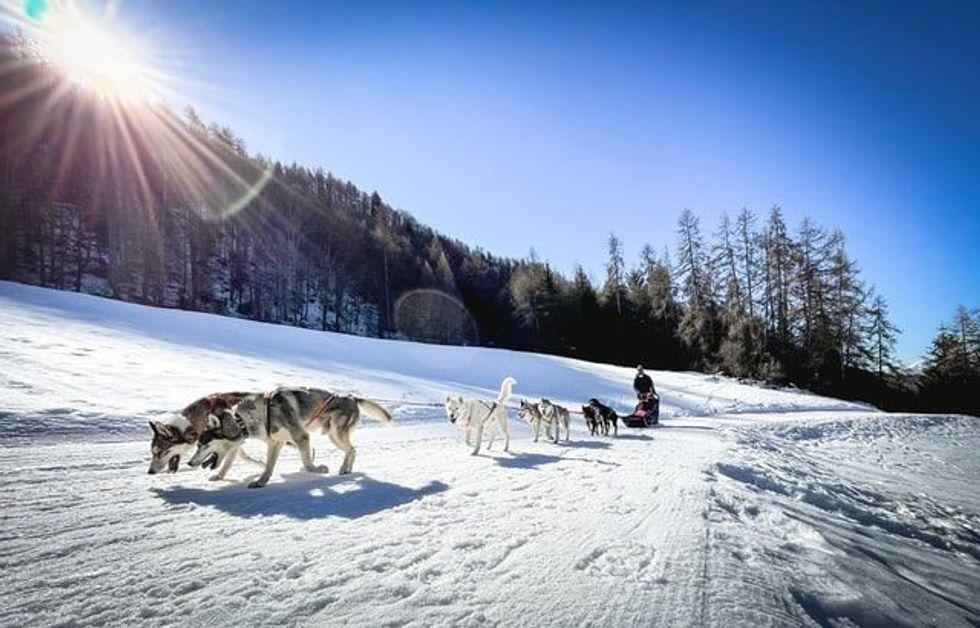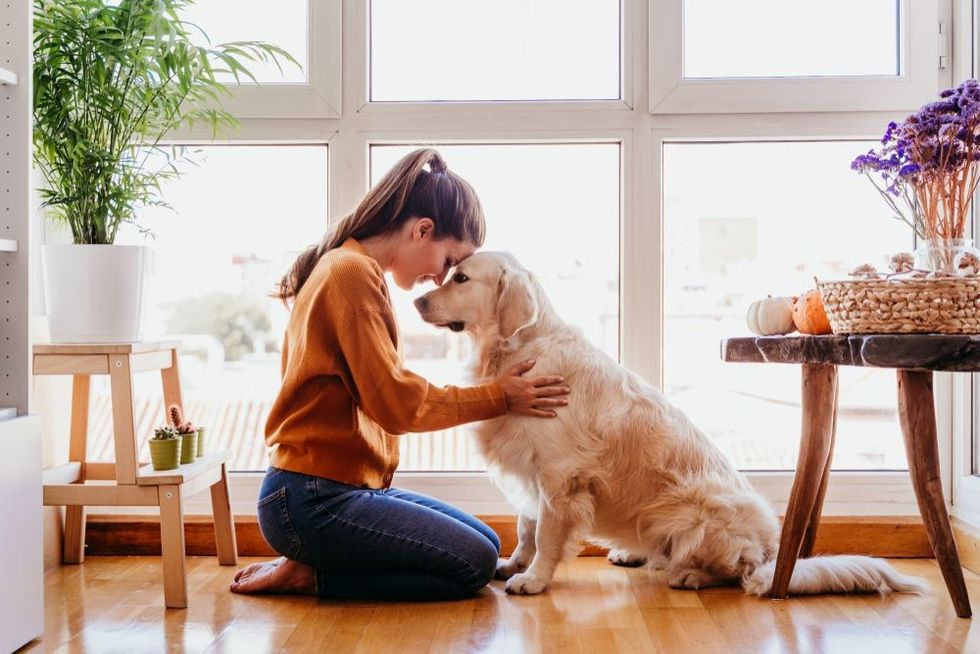Fun Anatolian Shepherd Dog Facts For Kids

Content
- What type of animal is an Anatolian Shepherd Dog?
- What class of animal does an Anatolian Shepherd Dog belong to?
- How many Anatolian Shepherd Dogs are there in the world?
- Where does an Anatolian Shepherd Dog live?
- What is an Anatolian Shepherd Dog's habitat?
- Who do Anatolian Shepherd Dogs live with?
- How long does an Anatolian Shepherd Dog live?
- How do they reproduce?
- What is their conservation status?
- What do Anatolian Shepherd Dogs look like?
- How cute are they?
- How do they communicate?
- How big is an Anatolian Shepherd Dog?
- How fast can an Anatolian Shepherd Dog run?
- How much does an Anatolian Shepherd Dog weigh?
- What are their male and female names of the species?
- What would you call a baby Anatolian Shepherd Dog?
- What do they eat?
- Are they slobbery?
- Would they make a good pet?
- Did you know...
- Having your own Anatolian Shepherd Dog
- Comparisons with other shepherd dogs
Anatolian Shepherd dogs were bred first in ancient Turkey as companions to the shepherds as the guardians of the flocks. Anatolians should not be confused with Kangal dogs.
Anatolians were bred to be large in height and weight and their coat color was decided according to their work so that they could be mixed among the flocks and wouldn't be recognized by the predators. They are surely one handsome breed.
Anatolians are pretty independent dogs. They used to find their own food when they went to guard their flock. They are also a very intelligent breed of dogs.
They make judgment calls and take their own decisions when they see danger. They suspect animals and people that are unknown to them. If they sense something suspicious, they will bark and let their owner know.
Their barks are loud and may sound like a roar. They also need something to do like a job most of the time to stay happy as they are a working breed of dog.
There's much more you should know before you take them home. Read on to get that information. If you like this article, then check out Field spaniel and Flat-coated retriever facts too.
Anatolian Shepherd Dog Interesting Facts
What type of animal is an Anatolian Shepherd Dog?
The Anatolian Shepherd is a kind of working dog. They are considered guard dogs too. These dogs are also of ancient lineage.
What class of animal does an Anatolian Shepherd Dog belong to?
The Anatolian Shepherd belongs to the Mammalia class of animals.
How many Anatolian Shepherd Dogs are there in the world?
These dogs are mainly domesticated dogs. So, their breedings mostly happen in households and by breeders. Therefore, the exact number of Anatolian Shepherds in the world is unknown at the moment.
Where does an Anatolian Shepherd Dog live?
An Anatolian Shepherd was first bred a long time ago for the shepherds. They were made so that the shepherds had a companion with them as their flock guardian.
They have since lived with humans as their companions, as a guard to their flock before, and now as a guard to their owners, their humans, and their household. These dogs mainly live in households now, but they need bigger places to live.
They are not at all suited for city apartments that are usually closed and small. The ancestors of these dogs used to roam around big field areas with their shepherds.
If not that, at least you should have a big backyard or somewhere they can play and roam around. These breeds of dogs are mainly better for farmers in the countryside or people who do the jobs of patrolling, like even for the police.
What is an Anatolian Shepherd Dog's habitat?
The Anatolian Shepherd is an ancient breed of dog that was first bred in Turkey for the purpose of serving as a working and livestock guardian dog to the shepherds.
They used to guard the flocks in very harsh weather that stayed all year round in the area. The breed was introduced to the world at a very late period of time comparing how old this breed of dogs is.
So, even though they have been living in stable, good weather now, they can stay in harsh weather areas too with plenty of space to cover.
Who do Anatolian Shepherd Dogs live with?
This breed of dogs is pretty independent in nature but since the beginning, they were bred for the reason of serving as companions to humans, to their owners.
So, from that time to now, they have been still living with humans as the best companion a human can get, and as the best guard to its human and working buddies.
How long does an Anatolian Shepherd Dog live?
The biggest threats to the lives of domesticated dogs are usually health issues or injuries. The Anatolian Shepherd is a rather hardy, healthy breed. They live for about 11-13 years long.
How do they reproduce?
The breeding of this dog usually happens under the supervision of breeders. If it happens in a home, then this information is necessary to know to breed the Anatolian.
Before breeding, both the dogs need to go through a series of tests and pass the rules or standards of the American Kennel Club. According to the Anatolian Shepherd Dog Club of America Inc., the breed matures very slowly and the females will not be ready for breeding until their second or third heat cycle.
The breeding process should not happen two heat cycles in a row and the females should not be taken for breeding more than three times.
These all also depend upon the health of the dogs. So, talking to a vet beforehand is always better.
The oestrus cycle of the females usually lasts up to 21 days but it can go up to four weeks for your dog. During the gestation period of 63 days, take care of your dog with extra attention and extra healthy foods.
What is their conservation status?
The conservation status of the Anatolian Shepherd is Not Evaluated in the conservation status of the International Union for Conservation of Nature. This is natural due to the fact that most of this breed of dog is either bred at the breeders or at home and this dog breed is also not that common.
So keeping a track of them is not a walk in the park. However, the good news would be that we can also understand by this that they are not threatened.
Anatolian Shepherd Dog Fun Facts
What do Anatolian Shepherd Dogs look like?
Anatolian Shepherds were first bred in ancient Turkey to keep them as livestock guardian. Their appearance depended upon this fact, so they could blend in with their herd.
These dogs are big in size and tough and calm looking. The calm-looking appearance changes though if they suspect something or someone nearby.
They have droopy ears and according to American Kennel Club, any color of the coat is acceptable. Anatolian Shepherds in pinto, brindle, white, and fawn colors are the most popular.
Most dogs of the breed have a black mask on their faces, while some do not. As they were bred in Turkey at such a time and place where they endured harsh weather throughout the year, these dogs have a double coat fur which helps them in both hot and cold weather.
The undercoat is short (about 1 in (2.5 cm)) with longer overcoat (about 4 in (10.1 cm)).
Their hair is a bit longer in their mane and neck. The eyes are mainly dark brown or amber-colored.
Their movement is fluid and speaks of their power and intelligence. All in all, they are surely tough and handsome ones of all the dogs.

How cute are they?
Anatolians may not seem cute because they are tough dog breeds. Their appearance radiates toughness and power. They have a large and hardy-built body with a large head.
Some Anatolians have black masks on their face and some don't. They have the ability to ward off much bigger, much more dangerous, and more ferocious-looking animals than them. Most of the time these dogs stay calm and they don't really ask for too much attention.
With such an independent allure to them, these dogs don't really give off cute vibes. They were bred to be guard dogs. So, we are guessing that the people who bred them succeeded given the appearance and the movements of Anatolian Shepherds.
How do they communicate?
All dogs have a common way of communication through their body language. This is true for any breed of dog, and Anatolians are no different.
Some examples of these are when their ears are relaxed, and their eyes are blinking in a relaxing way, it usually means that they're at peace or relaxed.
When they are rolling on the floor on their back, it generally means that they are looking for attention and love, or when they have their ears erected, standing up in a straight way, that means they are suspicious of something or alert.
Other than these, every breed of dog also has its own way of communicating. The Anatolian Shepherd dog breed was made for guarding the flocks, so usually these dogs have suspicious minds.
These dogs are usually a calm breed but they will start barking loudly on mainly two occasions. They bark when they see an unknown person or animal, or when they think that their owner or house is in danger.
If you have an Anatolian Shepherd, try to understand the difference between the two.
How big is an Anatolian Shepherd Dog?
Anatolian Shepherds are big dogs. According to American Kennel Club, among the Anatolian Shepherd dogs, the males stand at 29 in (73.6 cm) tall and the females stand 27 in (68.5 cm) tall.
The average measurements of a short, medium or large-sized dog vary a little but Anatolian Shepherds are definitely considered large dogs. Only go for Anatolians if you are ready to have a large dog.
How fast can an Anatolian Shepherd Dog run?
The Anatolian Shepherd is one of the fast-running dog breeds. Their top speed can reach about 34 mph (54 kph). They not only have speed, but they also love walking and they have the trait of being able to walk very far.
How much does an Anatolian Shepherd Dog weigh?
The Anatolian Shepherd is a large dog. The average weight of a male Anatolian Shepherd is 110-150 lb (50-58 kg) and of a female, it is 80-120 lb (40-54 kg). The average weight of a large animal is usually more than 55-60 lb (24-27 kg). So, compared to that, it can be seen that they can get pretty large.
What are their male and female names of the species?
The male Anatolian Shepherd dogs are called dog, and the females are called bitch.
What would you call a baby Anatolian Shepherd Dog?
All the baby dogs are called pups or puppies. So, the babies of Anatolian Shepherds would simply be Anatolian Shepherd dog puppies.
What do they eat?
The proper amount of food and the number of times it should be given depend upon a lot of variables. Anatolian Shepherd dogs are a large breed of dogs.
Their activities are medium. They can just lay down and relax when they want to, but as they are working dogs, they will need something to do.
So, you can ask your vet for the amount of food your dog will need to be fed. But, always opt for the amount of food that is right for big or large dogs.
According to the American Kennel Club, any kind of high-quality dog food will work with them, but it should be given according to their age. Food habits for every dog transition according to their age.
It's different when they are pups, changes when they mature and changes once again when they enter their senior years. The exact amount of the food should be discussed with the vet.
These dogs have a tendency of bloating and stomach problems. So, that needs to be watched out for and they should be given small meals many times throughout the day.
Whether they are given commercial dog food or vet-supervised tailor-made food, the diet should be balanced. They can be given treats for the means of training them better but not too much, because it may lead to obesity. Although, these dogs don't have the habit of eating too much.
These dogs are pretty independent and tend to their own. They used to find their own food back in the day when they were out guarding their flock. So, be wary that they still might catch some small animals from the outside.
Are they slobbery?
An Anatolian Shepherd doesn't drool too much. It's just the normal amount for a dog.
So, you won't need to worry about them being slobbery too much. They do like digging and being outside most of the time, however, so look out for dirt all over the floor.
If you see your Anatolian Shepherd drooling more than usual, you should contact the vet to know if it's normal or if it's the cause of something.
Would they make a good pet?
They are good pets. They are loyal, protective of their owners, alert at all times and they have medium to high energy levels. They are not recommended for families or people adopting dogs for the first time or people who have a small place.
These dogs are guard dogs. They were bred for that particular reason as flock guardians, and they have been that way since the beginning.
So, these dogs are protective of their flocks, whether it's livestock or their humans. Sometimes, they can get a little overprotective. So, you will need to watch for that.
These dogs are usually the kind that is suspicious of a lot of things. They don't do well around strangers or animals they don't know. However, they are excellent at times of danger. They have independent minds and they have been saving and protecting their flocks with their own intelligence since the beginning.
They are registered as working dogs under the American Kennel Club. They need some kind of job to do most of the time.
So, they would be excellent pets for farmers with access to open space or as a companion of police or security people who have the job of patrolling. They would not be good for families with small children as they might recognize the kids as their flock, which might lead to problems later on.
Did you know...
Anatolian Shepherd dogs also have many other names. Such as, Karabash Dog, Coban Kopegi or Kara bas.
Artifacts and books dating back to 2000 B.C. and 1800 B.C. include the description of Anatolian Shepherd dogs. They are one of the oldest dog breeds. It's incredible, being such a large-sized dog, that they are still thriving.
They weren't exported till the 20th century. Americans started importing them in the 1950s.
They came to the United States first for a project of the Department of Agriculture.
They protect cheetahs from farmers who shoot them to protect their livestock in Namibia. They are used to protect livestock and farmers from the cheetahs too.
They have appeared in a few movies in Hollywood, like 'Kate And Leopold', 'Cats And Dogs' and more.
They shed their undercoat twice a year and shed otherwise a fair amount throughout the year. They might have a little bit of a smell, but not too much.
Having your own Anatolian Shepherd Dog
If you do decide to keep an Anatolian Shepherd puppy as a pet, there are a few things you should know and keep in mind first. If you're taking them in a family or a small apartment, then don't.
They are not family dogs and they don't do well in a closed or small space. They still have the temperament of being the guard dogs that they were before.
They were made to be independent and to make their own decisions if they are ever in a situation where they had to protect their flock in a hurry and their owners were not around. Due to this independent mind, training them is much more difficult.
They are not prone to taking commands from someone.
Obedience training can be okay but they definitely do not need guard dog or protection training. They are always wary of people they don't know along with being territorial, which may lead them to not trust other dogs or animals.
So, it's better to fence around your place. The fence also should be at least 72 in (182 cm) in height.
Now, if you want to take them up as pets, then we would suggest you check out the shelters and adopt one.
If you're looking for an Anatolian Shepherd dog puppy, and want to buy them from breeders, they usually cost about $700-$2000 USD and the cost to keep them will be a bit high as they are big dogs.
Comparisons with other shepherd dogs
This breed is often confused with the Kangal dog. The Kangal dog is one that is an entirely separate breed.
There are many differences between them. The Kangal dog even looks quite different from an Anatolian Shepherd.
Kangal dogs were also first bred 700 years ago in Turkey as a guard dog breed to flocks of sheep, but they have many differences from Anatolians and are only registered at United Kennel Club. The Kangals are a bit longer in height than Anatolians. Kangals can be family dogs and they can be around children.
They are a more peaceful breed compared to the Anatolian Shepherd. Other than these, most characteristics of the two are similar, which is probably why they are confused as the same breed most of the time.
Here at Kidadl, we have carefully created lots of interesting family-friendly animal facts for everyone to discover! Learn more about some other mammals including Pitbull Chihuahua mix, or Cheagle.
You can even occupy yourself at home by drawing one on our Anatolian Shepherd coloring pages.
We Want Your Photos!
More for You
Sources
http://www.vetstreet.com/dogs/anatolian-shepherd
https://www.akc.org/dog-breeds/anatolian-shepherd-dog/
https://dogtime.com/dog-breeds/anatolian-shepherd-dog#/slide/1
See All
Bachelor of Arts specializing in Journalism and Mass Communication, Postgraduate Diploma in Sports Management

Moumita DuttaBachelor of Arts specializing in Journalism and Mass Communication, Postgraduate Diploma in Sports Management
A content writer and editor with a passion for sports, Moumita has honed her skills in producing compelling match reports and stories about sporting heroes. She holds a degree in Journalism and Mass Communication from the Indian Institute of Social Welfare and Business Management, Calcutta University, alongside a postgraduate diploma in Sports Management.
Bachelor of Science specializing in Computer Science

Chandan ShuklaBachelor of Science specializing in Computer Science
With a Bachelor's degree in Computer Science from Aryabhatta College, University of Delhi, Chandan is a skilled and passionate technophile. He has completed a machine learning training program and is adept in various programming languages. He has been working as a content writer for two years while also striving to become a proficient tech professional.
Disclaimer
1) Kidadl is independent and to make our service free to you the reader we are supported by advertising. We hope you love our recommendations for products and services! What we suggest is selected independently by the Kidadl team. If you purchase using the Buy Now button we may earn a small commission. This does not influence our choices. Prices are correct and items are available at the time the article was published but we cannot guarantee that on the time of reading. Please note that Kidadl is a participant in the Amazon Services LLC Associates Program, an affiliate advertising program designed to provide a means for sites to earn advertising fees by advertising and linking to Amazon. We also link to other websites, but are not responsible for their content.
2) At Kidadl, we strive to recommend the very best activities and events. We will always aim to give you accurate information at the date of publication - however, information does change, so it’s important you do your own research, double-check and make the decision that is right for your family. We recognise that not all activities and ideas are appropriate for all children and families or in all circumstances. Our recommended activities are based on age but these are a guide. We recommend that these ideas are used as inspiration, that ideas are undertaken with appropriate adult supervision, and that each adult uses their own discretion and knowledge of their children to consider the safety and suitability. Kidadl cannot accept liability for the execution of these ideas, and parental supervision is advised at all times, as safety is paramount. Anyone using the information provided by Kidadl does so at their own risk and we can not accept liability if things go wrong.
3) Because we are an educational resource, we have quotes and facts about a range of historical and modern figures. We do not endorse the actions of or rhetoric of all the people included in these collections, but we think they are important for growing minds to learn about under the guidance of parents or guardians.







